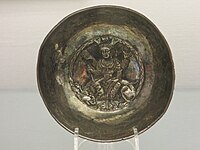Nana (Bactrian goddess)
Nana (Kushan Greek: Νανα, Ναναια, Ναναϸαο, Sogdian nny) was a Bactrian female divinity from ancient Bactria, a variation of pan-Asiatic Nana, a conflation of Sumero-Babylonian Inanna-Ishtar with a local divinity, in her Kushan form with the indigenous (Zoroastrian) Harahvati Aredvi Sura Anahita. Such syncretism was common among the Kushan deities.
Nana is first attested by name on a coin of Sapadbizes, a 1st-century BCE king of Bactria who preceded the Kushans. In this singular case, Nana is depicted as a lion. Nana then reappears two centuries later on the coins and seals of the Kushan kings, in particular of the mid-2nd century CE Kanishka I. The Rabatak inscription of Kanishka I invokes her as well. Her characteristics are martial in these depictions, and she was typically depicted as a seated martial goddess, escorted by a lion,[2] which is almost similar to the Hindu goddess of war Durga, who rides on a lion and protects her devotees from evils. She was also associated with fertility, wisdom and the waters (in particular of the Indus River, which was known as Harahuati in the Avesta and of which Harahuati Ardevi Sura Anahita was the patron).
The Kushan territories encompassed the Iranian-language speaking regions of Sogdiana, Ferghana, Bactria and Arachosia, and the conquered Indian territory of Gandhara, and Mathura. Those provinces lie in the modern states of Afghanistan, Tajikistan, Uzbekistan and northwestern India. Depictions of Nana are known from Afghanistan as late as the 5th-6th century CE.[3] In Afghanistan and Pakistan the name appears as "Nawi", the Pashto word for bride.[2]
Gallery[]

Coin of Sapadbizes (c. 10 BCE), with the lion, moon crescent, and legend Ναναια on the reverse.

Coin of Kanishka I (Circa 100-126 CE), with goddess Nana
Silver bowl from Khwarezm depicting a four-armed goddess seated on a lion, possibly Nana. Dated 658 AD, British Museum.[4]

Bunjikat wall painting of goddess Nana
References[]
- ^ "Metropolitan Museum of Art". www.metmuseum.org.
- ^ a b Bremmer, Jan N. (2007). The strange world of human sacrifice. p. 176. ISBN 9789042918436. Retrieved 2013-02-09.
- ^ Metropolitan Museum of Art, permanent exhibit
- ^ British Museum Collection
- Asian goddesses
- Archaeology of Afghanistan
- Inanna
- Anahita




